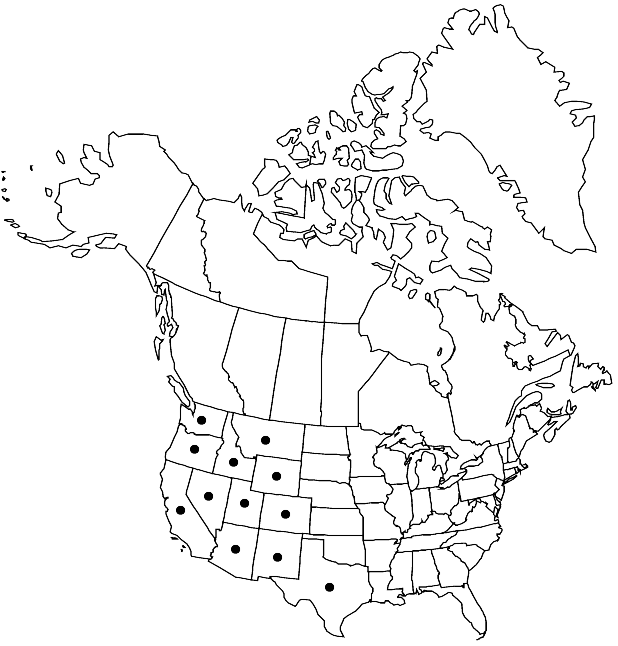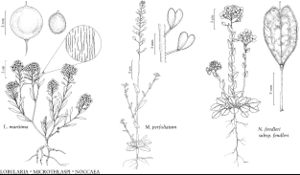Noccaea fendleri
Preslia 70: 108. 1998.
Perennials; (cespitose or not). Stems simple or several from caudex, erect or ascending, unbranched or branched distally, (0.1–)0.4–3.2(–4.5) dm. Basal leaves: petiole 0.4–7.3 cm; blade linear, oblong, oblanceolate, ovate, obovate, or spatulate, 0.4–3 cm × 2–20 mm, base cuneate to attenuate, margins entire, denticulate, or dentate, apex obtuse to acute. Cauline leaves 2–21; blade ovate or suboblong, 0.4–2.8 × 0.1–1.7 mm, base auriculate to subamplexicaul, margins entire or dentate, apex obtuse to subacute. Racemes 0.5–25 cm, (congested or considerably elongated). Fruiting pedicels horizontal to ascending, straight, 2.5–15 mm. Flowers: sepals 1.6–5.3 × 0.5–1.5 mm, (margins membranous); petals white to pinkish purple, (3.4–)4.2–13 × 1–4.9 mm, often flaring between blade and claw, apex obtuse; filaments 2–7.5 mm; anthers 0.5–1 mm. Fruits obovate, obcordate, obdeltate, or elliptic, 2.5–16 × 1.5–9 mm, usually winged, rarely not winged apically, base cuneate, apex obtuse, truncate, or emarginate; ovules 4–10 per ovary; style (0.4–)1.1–4.2 mm. Seeds brown, 1.1–2.1 mm, minutely reticulate.
Distribution

Ariz., Calif., Colo., Idaho, Mont., N.Mex., Nev., Oreg., Tex., Utah, Wash., Wyo., n Mexico.
Discussion
Subspecies 5 (5 in the flora).
Some North American authors (e.g., P. K. Holmgren 1971; R. C. Rollins 1993) treated Noccaea fendleri as conspecific with the European Thlaspi montanum, whereas others (e.g., E. B. Payson 1926) recognized the North American taxa as endemic to the continent. Molecular studies (M. Koch and I. A. Al-Shehbaz 2004) supported Payson’s view of the independent status of the North American representatives. Although Payson and Rollins recognized more than one species here (e.g., T. californicum, T. idahoense, T. glaucum, T. fendleri), I agree with Holmgren in treating them as infraspecific taxa, but at the subspecific instead of varietal rank. The distinctions among them are not very sharp, and hybridization appears to have played some role in blurring their boundaries, as evidenced from Holmgren’s report of morphologically intermediate forms between subsp. glauca (as T. montanum var. montanum) and each of subspp. fendleri, idahoensis, and siskiyouensis.
Selected References
None.
Lower Taxa
Key
| 1 | Fruits elliptic, 2.2-3.2 times as long as wide, apices acute; fruiting pedicels strongly ascending to divaricate-ascending, forming 15-70º angle with rachises. | Noccaea fendleri subsp. californica |
| 1 | Fruits obovate, obcordate, obdeltate, or, rarely, elliptic, 1-2 times as long as wide, apices obtuse, truncate, or emarginate; fruiting pedicels subhorizontal, horizontal, or descending, forming 70-130º angle with rachises | > 2 |
| 2 | Basal leaf blades linear to narrowly oblanceolate, 1.1-4(-5) mm wide, bases attenuate; central Idaho. | Noccaea fendleri subsp. idahoensis |
| 2 | Basal leaf blades oblong, ovate, or spatulate, (3.5-)4-20 mm wide, bases cuneate; widespread in Pacific and Mountain states | > 3 |
| 3 | Seeds 2-4 per fruit; petioles of basal leaves (1.7-)2-3.6(-4) times longer than blades; cauline leaves 2-6; Curry, Douglas, and Josephine counties, Oregon. | Noccaea fendleri subsp. siskiyouensis |
| 3 | Seeds 4-6 per fruit; petioles of basal leaves 0.6-2.2(-3.3) times longer than blades; cauline leaves 4-16(-21); Arizona, California, Colorado, Idaho, Montana, Nevada, New Mexico, Oregon, Texas, Utah, Washington, Wyoming | > 4 |
| 4 | Petals pinkish purple or, occasionally, white, (6-)6.5-11(-13) mm; styles (1.8-) 2.5-3.5(-4.2) mm; fruits 7-12(-16) mm; racemes often compact. | Noccaea fendleri subsp. fendleri |
| 4 | Petals white or, occasionally, pinkish purple, (3.4-)4-7(-8.5) mm; styles (0.4-) 1-2.2(-3) mm; fruits (2.5-)5-8(-12) mm; racemes often lax. | Noccaea fendleri subsp. glauca |
